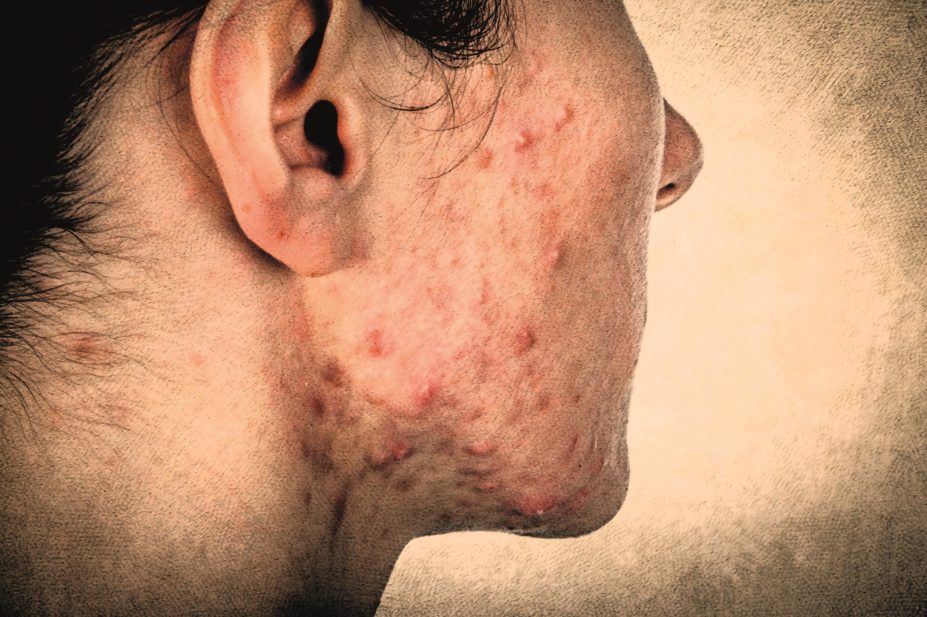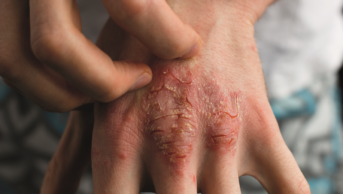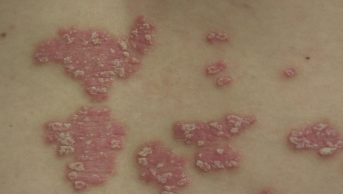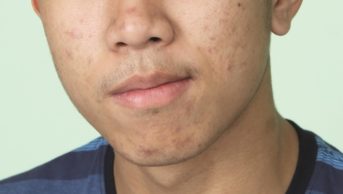
Shutterstock.com
Topical and oral antibiotics have been used to treat acne vulgaris for decades, but recent reports highlight the dangers of increasingly antibiotic-resistant Propionibacterium acnes
[1]
,[2]
,[3]
,[4]
, the commensal bacteria that play a critical role in acne pathogenesis[5]
. Liberal and inappropriate use of antibiotics has contributed to P. acnes resistance and could lead to the development of a ‘superbug’, untreatable by modern-day therapies. The US Food and Drug Administration’s (FDA) recent approval of the first over-the-counter (OTC) topical retinoid in the United States allows patients to buy an effective non-antimicrobial product to treat their condition. New Zealand and Singapore are other countries that have recently approved OTC sales of topical retinoids and other countries should follow suit. Access to efficacious OTC products and education on correctly using them could reduce antibiotic use and combat the global threat of antibiotic resistance.
Burden beyond physical appearance
Acne is the eighth most prevalent disease in the world, affecting an estimated 645 million people globally. Around US$3bn is lost each year in direct and indirect costs of treatment and loss of productivity in the United States alone[6],[7]
, and acne is second only to dermatitis as the leading cause of skin disease burden worldwide[8]
. The profound psychosocial effects of acne, in addition to physical disfigurement, have been recognised for more than 60 years and include various psychiatric comorbidities, such as depression, anxiety, body image disorder, obsessive-compulsive disorder and personality disorders[9]
,[10]
,[11]
. The condition is traditionally seen in adolescents, but post-adolescent acne is also common and occurs more frequently in women compared with men[12],[13]
. Acne treatment has evolved to include an array of OTC and prescription therapies, but a recent assessment revealed a lack of standardised outcome measures in acne trials, which hinders head-to-head comparison among studies[14]
. Remarkably, between 2005 and 2013, the measured burden from acne remained relatively stable.
Resistant strains of P. acnes affect not only the antibiotic user, but also others who come into close contact
Treating acne
Options for treating acne include a range of topical and systemic retinoids, and topical and systemic antimicrobials[5]
. The typical therapeutic approach is a step-wise escalation of therapy based on disease severity and clinical response[15]
. Non-inflammatory comedonal acne is typically treated with benzoyl peroxide (BPO), a topical retinoid, or a topical combination therapy (BPO plus a topical retinoid, or BPO plus a topical antimicrobial). Mild inflammatory acne (pustular or mixed papulopustular) generally requires a topical antimicrobial with a topical retinoid and BPO, while an oral antibiotic is often added to the topical antimicrobial and topical retinoid regimen for moderate inflammatory acne. Severe or nodular acne may require initiation of oral isotretinoin.
Use of antibiotics
Antibiotics have assumed a routine role in acne treatment but the mechanism of antibiotic efficacy is not fully understood, although anti-inflammatory properties are known to be important[16]
. Topical antibiotics are usually well tolerated; however, oral antibiotics can cause systemic adverse effects, including photosensitivity and gastrointestinal reactions with doxycycline, and vestibular effects and abnormal pigmentation with minocycline.
P. acnes belongs to the growing list of antibiotic-resistant organisms, including Escherichia coli, Staphylococcus aureus, gonorrhoea, tuberculosis, malaria, influenza and HIV[3],[4],[17]
,[18]
. The field of dermatology plays an active role in the global epidemic of increasing antibiotic resistance and emerging strains of superbugs, owing to the extended duration of treatment with antibiotics. Antibiotic-resistant P. acnes has been reported for more than three decades, and more than half of all P. acnes strains are reported as resistant in all major world regions[3],[19]
. The myriad of clinical effects of resistance include reduced treatment response, no response, or disease relapse; and resistant strains affect not only the antibiotic user but also others who come in close contact with the patient.
BPO, a broad-spectrum topical antimicrobial, has a bactericidal effect on P. acnes but, remarkably, resistance of P. acnes does not affect the efficacy of BPO[20]
,[21]
. Daily use of a 6% BPO cleanser has been shown to reduce counts of resistant P. acnes strains by at least 2-log after three weeks of treatment[22]
. This novel property has promoted combinations of BPO and topical antibiotics to prevent selection of resistant P. acnes, and this combination of products is superior in efficacy to use of either product alone[23]
,[24]
. The Global Alliance to Improve Outcomes in Acne and the American Academy of Dermatology strongly recommend the combination of a BPO-containing regimen or using BPO as a washout between antibiotic courses[25]
. Both organisations also do not recommend using oral or topical antibiotics as monotherapy or the concurrent use of oral and topical antibiotics. Treatment with oral antibiotics should be limited to the shortest duration possible — generally three months. Unfortunately, investigation of acne treatment among GPs in the UK revealed that 29% of oral antibiotic courses exceed six months and more than 60% are not associated with a topical retinoid[26]
. This prescribing behaviour is discordant with current guidelines and represents an area of significant potential change.
Role of topical retinoids
Topical retinoids are a cornerstone of acne treatment and are the preferred agents in maintenance therapy[27]
. These vitamin A derivatives promote normal desquamation of the follicular epithelium, which inhibits comedogenesis and deactivates inflammatory cascades that promote acne pathology. Topical retinoids also improve post-inflammatory hyperpigmentation, which is more common in patients with dark skin. Topical retinoids significantly reduce acne lesions, including both non-inflammatory and inflammatory lesions[28]
,[29]
,[30]
. Tretinoin, tazarotene and adapalene are the most commonly prescribed topical retinoids. The primary adverse effects of this class of medicine are skin irritation, dryness, peeling and erythema, and to minimise these effects, retinoids are often started with nightly use for at least 8–12 weeks. Topical retinoids are used cautiously in pregnancy because there are conflicting data on their effect on foetal malformations[31]
,[32]
. Topical tazarotene is classified as FDA pregnancy category X (studies in animals or humans have demonstrated foetal abnormalities), while tretinoin and adapalene are pregnancy category C (animal reproduction studies have shown an adverse effect on the foetus and there are no adequate and well-controlled studies in humans, but potential benefits may warrant use of the drug in pregnant women despite potential risks).
Topical retinoids are a cornerstone of acne treatment and are the preferred agents in maintenance therapy
Importance of OTC availability
The convenience and lower cost of OTC acne treatments have strong appeal to consumers, who are also frequently confronted with web, television, radio and store shelf advertisements of products. OTC formulations containing ingredients such as BPO and salicylic acid are readily available, as well as mechanical acne treatments designed for skin exfoliation, including oscillating brushes, various scrubs and cleansing cloths[33]
. However, a literature review has revealed that manufacturers often fund studies on their OTC acne products, and there is a striking paucity of double-blind or investigator-blind, randomised and vehicle-controlled clinical studies[34]
.
Topical retinoids have proven efficacy in most stages of acne treatment. These medicines traditionally required a prescription for use until July 2016, when the FDA approved an over-the-counter formulation of topical adapalene gel (Differin Gel) in the United States[35]
. The 0.1% gel is the lowest available dose of the medicine and is approved for daily use in consumers aged 12 years and over. The medicine’s efficacy and safety as an OTC product was supported by data from a 1996–2016 post-marketing safety analysis, a maximal use trial and consumer studies, including a label comprehension study, a self-selection study and an actual use trial[35]
. The FDA advisory committee determined that consumers are able to understand and follow information presented on the OTC label to use adapalene safely. As a precaution, women who are pregnant, planning to become pregnant or are breastfeeding are advised to consult a doctor before use. The FDA’s decision coincides with an investigation by the European Medicines Agency (EMA) regarding the effectiveness of pregnancy prevention and risk of neuropsychiatric disorders with retinoid-containing medical products[36]
.
The cost-effectiveness of OTC compared with prescription adapalene is not yet realised. Although prescriptions for the medicines can be billed to insurance companies in the United States, many consumers are required to make a trivial copayment. At the time of writing, OTC adapalene manufactured by Galderma was not available on store shelves. However, the OTC adapalene will be the sole FDA-approved OTC prescription-strength topical retinoid, perhaps allowing the manufacturer a limited-time monopoly over pricing.
Growing OTC market is a good thing
According to market research company BCC Research, the global acne medicine market was valued at US$3.5bn in 2012 and is projected to reach US$4.5bn by 2018[37]
. As economic conditions improve, greater disposable income promotes consumer investment in more expensive OTC acne products. If OTC adapalene is used as directed by the product label, the product has the safety and efficacy of the prescription adapalene that has been recommended by dermatologists for years. The availability of efficacious OTC acne products has the potential to reduce antibiotic use in the treatment of acne and combat antimicrobial resistance on a global scale. The FDA’s approval of OTC retinoid therapy sets a precedent for other world nations to replicate. Global competition and innovation will ultimately change the way consumers and physicians treat this ubiquitous disorder.
Chante Karimkhani is a research fellow at the Department of Dermatology, University of Colorado, United States. Robert P Dellavalle is the chief of the dermatology service at the US Department of Veterans Affairs, Eastern Colorado Health Care System, Denver, United States. Correspondence email to: ck2525@caa.columbia.edu
Declarations of interest: none
References
[1] Brown L. Doctors warn acne could become resistance to antibiotics. BBC Newsbeat. 5 July 2016. Available at: http://www.bbc.co.uk/newsbeat/article/36712810/doctors-warn-acne-could-become-resistant-to-antibiotics (accessed September 2016).
[2] Wechsler Linden D. The problem with adult acne. The Wall Street Journal. 5 January 2015. Available at: http://www.wsj.com/articles/the-problem-with-adult-acne-1420501469 (accessed 10 September 2016).
[3] Walsh TR, Efthimiou J & Dreno B. Systematic review of antibiotic resistance in acne: an increasing topical and oral threat. Lancet Infect Dis 2016;16:e23–e33. doi: 10.1016/S1473-30 99(15)00527-7
[4] Humphrey S. Antibiotic resistance in acne treatment. Skin Therapy Lett 2012;17:1–3. PMID: 23032935
[5] James WD, Berger TG & Elston DM. Acne. In: Andrews’ diseases of the skin. Philadelphia: Elsevier; 2015. p.264.
[6] Vos T, Flaxman AD, Naghavi M et al. Years lived with disability (YLDs) for 1160 sequelae of 289 diseases and injuries 1990–2010: a systematic analysis for the Global Burden of Disease Study 2010. Lancet 2012;380:2163–2196. doi: 10.1016/S0140-6736(12)61729-2
[7] Bhate K & Williams HC. Epidemiology of acne vulgaris. Br J Dermatol 2013;168:474–485. doi: 10.1111/bjd.12149
[8] GBD 2013 DALYs and HALE Collaborators. Global, regional, and national disability-adjusted life years (DALYs) for 306 diseases and injuries and healthy life expectancy (HALE) for 188 countries. 1990–2013: quantifying the epidemiological transition. Lancet 2015;386:2145–2191. doi: 10.1016/S0140-6736(15)61340-X
[9] Sulzberger MB & Zaidens S. Psychogenic factors in dermatologic disorders. Med Clin North Am 1948;32:669–685. PMID: 18857202
[10] Arnold LM, McElroy SL, Mutasim DF et al. Characteristics of 34 adults with psychogenic excoriation. J Clin Psychiatry 1998;59:509–514. PMID: 9818631
[11] Koo JY & Smith LL. Psychological aspects of acne.Pediatr Dermatol 1991;8(3):185–188. PMID: 1836060
[12] Yentzer BA, Hick J, Reese EL et al. Acne vulgaris in the United States: a descriptive epidemiology. Cutis 2010;86:94–99. PMID: 20919604
[13] Goulden V, Clark SM & Cunliffe WJ. Post-adolescent acne: a review of clinical features. Br J Dermatol 1997;136:66–70. doi: 10.1046/j.1365-2133.1997.d01-1144.x
[14] Stein Gold L, Tan J & Kircik L. Evolution of acne assessments and impact on acne medications: An evolving, imperfect paradigm. J Drugs Dermatol 2016;15:79–86. PMID: 26741385
[15] Zaenglein AL, Pathy AL, Schlosser BJ et al. Guidelines of care for the management of acne vulgaris. J Am Acad Dermatol 2016;74:945–973. doi: 10.1016/j.jaad.2015.12.037
[16] Mills O Jr, Thornsberry C, Cardin CW et al. Bacterial resistance and therapeutic outcome following three months of topical acne therapy with 2% erythromycin gel versus its vehicle. Acta Derm Venereol 2002;82:260–265. PMID: 12361129
[17] Patel M, Bowe WP, Heughebaert C et al. The development of antimicrobial resistance due to the antibiotic treatment of acne vulgaris: a review. J Drugs Dermatol 2010;9:655–664. PMID: 20645527
[18] World Health Organization. Antimicrobial resistance. September 2016. Available at: http://www.who.int/mediacentre/factsheets/fs194/en/ (accessed September 2016).
[19] Leyden JJ, McGinley KJ, Cavalieri S et al. Propionibacterium acne resistance to antibiotics in acne patients. J Am Acad Dermatol 1983;8:41–45. PMCID: PMC163871
[20] Sagranksy M, Yentzer BA & Felderman SR. Benzoyl peroxide: a review of its current use in the treatment of acne vulgaris. Expert Opin Pharmocother 2009;10:2555–2562. doi: 10.1517/14656560903277228
[21] Ozolins M, Eady EA, Avery AJ et al. Comparison of five antimicrobial regimens for treatment of mild to moderate inflammatory facial acne vulgaris in the community: randomised controlled trial. Lancet 2004;3649:2188–2195. doi: 10.1016/S0140-6736(04)17591-0
[22] Leyden JJ, Wortzman M & Baldwin EK. Antibiotic-resistant propionibacterium acnes suppressed by a benzoyl peroxide cleanser 6%. Cutis 2008;82:417–421. PMID: 19181031
[23] Lookingbill DP, Chalker DK, Lindholm JS et al. Treatment of acne with a combination clindamycin/benzoyl peroxide gel compared with clindamycin gel, benzoyl peroxide gel and vehicle gel: combined results of two double-blind investigations. J Am Acad Dermatol 1997;37:590–595. PMID: 9344199
[24] Leyden JJ, Hickman JG, Jarratt MT et al. The efficacy and safety of a combination benzoyl peroxide/clindamycin topical gel compared with benzoyl peroxide aloen and a benzoyl peroxide/erythromycin combination product. J Cutan Med Surg 2001;5:37–42. PMID: 11281433
[25] Thiboutot D, Gollnick H, Bettoli V et al. New insights into the management of acne: An update from the global alliance to improve outcomes in acne group. J Am Acad Dermatol 2009;60:S1–S50. doi: 10.1016/j.jaad.2009.01.019
[26] Barbieri JS, Hoffstad O & Margolis DJ. Duration of oral tetracycline-class antibiotic therapy and use of topical retinoids for the treatment of acne among general practitioners (GP): A retrospective cohort study. J Am Acad Dermatol 2016. doi: 10.1016/j.jaad.2016/06/057 [Epub ahead of print]
[27] Thiboutot DM, Shalita AR, Yamauchi PS et al. Adapalene gel, 0.1%, as maintenance therapy for acne vulgaris: a randomized, controlled, investigator-blind follow-up of recent combination study. Arch Dermatol 2006;142:597–602. doi: 10.1001/archderm.142.5.597
[28] Krishnan G. Comparison of two concentrations of tretinoin solution in the topical treatment of acne vulgaris. Practitioner 1976;216:106–109. PMID: 131310
[29] Kawashima M, Harada S, Loesche C et al. Adapalene gel 0.1% is effective and safe for Japanese patients with acne vulgaris: a randomized, multicenter, investigator-blinded, controlled study. J Dermatol Sci 2008;49:241–248. doi: 10.1016/j.jdermsci.2007.09.012
[30] Shalita AR, Berson DS, Thiboutot DM et al. Effects of tazarotene 0.1% cream in the treatment of facial acne vulgaris: pooled results from two multicenter, double-blind, randomized, vehicle-controlled, parallel-group trials. Clin Ther 2004;26:1865–1873. doi: 10.1016/j.clinthera.2004.11.01
[31] Kaplan YC, Ozsarfati J, Etwel F et al. Pregnancy outcomes following first-trimester exposure to topical retinoids: a systematic review and meta-analysis. Br J Dermatol 2015;173:1132–1141. doi: 10.1111/bjd.14053
[32] Lipson AH, Collins F & Webster WS. Multiple congenital defects associated with maternal use of topical tretinoin. Lancet 1993;341:1352–1353. PMID: 8098487
[33] Bowe WP & Shalita AR. Effective over-the-counter acne treatments. Semin Cutan Med Surg 2008;27:170–176. doi: 10.1016/j.sder.2008.07.004
[34] Decker A & Graber E. Over-the-counter acne treatments. J Clin Aesthet Dermatol 2012;5:32–40. PMCID: PMC3366450
[35] US Food & Drug Administration. FDA approves Differin gel 0.1% for over-the-counter use to treat acne. 8 July 2016. Available at: http://www.fda.gov/NewsEvents/Newsroom/PressAnnouncements/ucm510362.htm (accessed 30 August 2016).
[36] European Medicines Agency. Retinoid-containing medicinal products. Available at: http://www.ema.europa.eu/ema/index.jsp?curl=pages/medicines/human/referrals/Retinoids_containing_medicinal_products/human_referral_prac_000061.jsp&mid=WC0b01ac05805c516f (accessed September 2016).
[37] Dolcera Public Wiki. OTC products for acne treatment. Available at: http://www.dolcera.com/wiki/index.php?title=OTC_products_for_acne_treatment#Global_Acne_Medications_Market (accessed September 2016).


